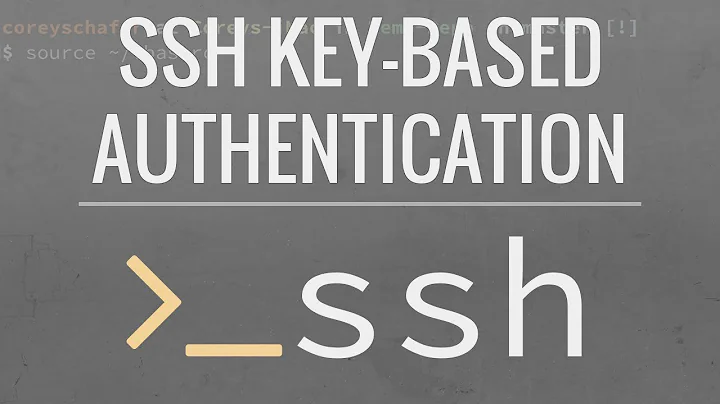Induce Mac graphical login from SSH
Solution 1
Not knowing the password makes things complicated, but maybe the solution is: is it possible to temporarily blank out a user's password? (And afterwards reset it to whatever it was before.)
As a start:
First, get the login window to display. Just log out the current user, use fast user switching, or use SSH:
cd "/System/Library/CoreServices/Menu Extras/User.menu/Contents/Resources/" sudo ./CGSession -suspend
Or, to switch to a specific user right away, which will probably show the login window (this suddenly no longer works on my 10.5 Leopard):
sudo ./CGSession -switchToUserID 501
What's shown now depends a bit on the System Preferences, but let's assume it's the users' icons and their names. To activate a name we'd have to type the first letters. Then, after Return, the password prompt shows. Alternatively one can select any name (like by pressing Arrow Down) and then press Option-Return to be prompted for both any username and its password. I don't know how one can tell which screen is shown, but let's save that for later...
So, to select the first (random) user name and press Option-Return, type a specific user name, hit Return, and type the password:
sudo osascript -e 'tell app "System Events" key code 125 keystroke return using option down keystroke "the username" delay 1.0 keystroke return delay 1.0 keystroke "the password" delay 1.0 keystroke return end tell'
The above shows some error, which as far as I can tell does not limit the usage:
osascript[285] : 3891612: (connectAndCheck) Untrusted apps are not
allowed to connect to or launch Window Server before login.
_RegisterApplication(), FAILED TO establish the default connection to
the WindowServer, _CGSDefaultConnection() is NULL.
Alternatively, use the language specific script from "Script the Login window through Apple Remote Desktop" (maybe one day the comments at that site will show a better solution):
tell process "SecurityAgent" set value of text field 1 of group 1 of window 1 to "the username" set value of text field 2 of group 1 of window 1 to "the password" end tell click button "Log In" of window 1 of application process "SecurityAgent"
But the main problem is: this still needs the password. However: obviously no password is needed when a user has a blank password. In fact, for blank passwords just clicking a user's icon is all that's needed. So, if sending keystrokes using AppleScript is acceptable, then maybe "all" that's left to figure out:
Is it possible to temporarily blank out a user's password, to allow for starting (or resuming) the session without knowing that password...?
-
Can one make the AppleScript error-proof? Like:
- How to tell if the login window is visible? (maybe
stat -f%Su /dev/consolecan help, as that yieldsrootwhile the login window is displayed) - How to tell which login window is shown? (Like: one showing icons and login names, or a dropdown list, or maybe only a password prompt if someone selected to switch to some specific user?)
- Get rid of the delays.
- What about that error message?
- How to tell if the login window is visible? (maybe
(A note for testing: when using Screen Sharing it seems that setting the preference When controlling computers: Encrypt passwords and keystrokes only also retains the connection when the login window is shown, or after a user has successfully logged in. When using Encrypt all network data then my Mac needs to re-establish the Screen Sharing connection each time a login is shown or a user is switched.)
Solution 2
I've been investigating this recently.
Put this in your app's PAM stack, or test with sshd:
session required pam_launchd.so launchd_session_type=Aqua
That goes a long way towards getting you a graphical session which is pretty close to a switched-out user session. In particular, it's in the right bootstrap namespace and has the correct bootstrap ports (I think). You can check the source for what pam_launchd does; it's using some reasonable-looking private library (vproc_priv.h functions in libvprop) to call the Mach routines for setting up the ports and namespace. It matches with all the (limited) docs Apple provides for the Mach-derived syscalls.
Next, you need to set your audit user-id to the that of the user with the BSM API, or the loginwindow won't talk to you on Lion.
The session looks very close to a switched-out session now if you check "launchctl blist", and some processes and services come to life nicely (like the pasteboard, and so on). In fact, everything except Finder and loginwindow is running. Until loginwindow runs though, you can't launch a graphical application, and the per-session loginwindow process is always spawned as a direct child of the global one. How does one poke the loginwindow process to launch a new loginwindow in the fresh session? I can't find a way to get the last piece in place!
Any help completing this answer gratefully received.
Related videos on Youtube
Sophie Alpert
Updated on September 17, 2022Comments
-
 Sophie Alpert almost 2 years
Sophie Alpert almost 2 yearsHow do I induce the Mac graphical login from SSH? Is there a way to make the
loginwindowprocess start a user session by running a command when remotely logged in via SSH as an admin on Mac OS X?When the machine is at the login window (no user is currently logged in), I want it to open up a user's session as if I had clicked on the username and entered a password.
Solutions that don't involve scripting the GUI are highly preferred, but this Apple KB page may be of interest for those who go that route.
-
 Sophie Alpert almost 15 yearsThis is a good start, but it has two problems. First, it doesn't work if you're at the login window, which is what I wanted, and it asks for a password, which I'd prefer it didn't. Since it's root, it should be able to switch users without the password.
Sophie Alpert almost 15 yearsThis is a good start, but it has two problems. First, it doesn't work if you're at the login window, which is what I wanted, and it asks for a password, which I'd prefer it didn't. Since it's root, it should be able to switch users without the password. -
 Arjan almost 15 yearsAha. I don't even know how to login as another user when sitting at the computer itself, so no cigar for
Arjan almost 15 yearsAha. I don't even know how to login as another user when sitting at the computer itself, so no cigar forsudo osascript -e 'tell app "System Events" to keystroke "password" & return'. With the screen locked, entering an administrative user name and password resumes the other user's session. But how to start a session for any user without knowing the password? (Just to be sure, if you know the password: another workaround might be Screen Sharing, which also works for the login screen. You'll need to reconnect the Screen Sharing after a specific user session is started or resumed.) -
 Sophie Alpert almost 15 yearsThis is good. I'd prefer a solution without manually simulating keystrokes, though.
Sophie Alpert almost 15 yearsThis is good. I'd prefer a solution without manually simulating keystrokes, though. -
 Arjan almost 15 yearsI wonder if anyone knows how to start a session for somebody else. So, without considering the above answer, just in the daily use of Mac OS X: can an administrator log in as another user, without knowing that user's password? (Just like
Arjan almost 15 yearsI wonder if anyone knows how to start a session for somebody else. So, without considering the above answer, just in the daily use of Mac OS X: can an administrator log in as another user, without knowing that user's password? (Just likesuon the command prompt, but then for a GUI session. Or just like when the screen is locked, where entering an administrative user name and password resumes the other user's session.) -
 Sophie Alpert almost 15 yearsPerhaps it's not possible to do it without AppleScript keystroking: docs.info.apple.com/article.html?path=RemoteDesktop/3.0/en/…
Sophie Alpert almost 15 yearsPerhaps it's not possible to do it without AppleScript keystroking: docs.info.apple.com/article.html?path=RemoteDesktop/3.0/en/… -
 Arjan almost 15 yearsHmmm, good find, that article! If AppleScript and the keystrokes are acceptable, then maybe we should continue the quest then by finding a way to temporarily blank the password.
Arjan almost 15 yearsHmmm, good find, that article! If AppleScript and the keystrokes are acceptable, then maybe we should continue the quest then by finding a way to temporarily blank the password. -
 Sophie Alpert almost 15 yearsI'd definitely prefer a solution that doesn't need fake keystroking.
Sophie Alpert almost 15 yearsI'd definitely prefer a solution that doesn't need fake keystroking. -
 Arjan almost 15 yearsOkidoki, then I can't help you.
Arjan almost 15 yearsOkidoki, then I can't help you.

![Run Graphical X Applications Over SSH [Tutorial]](https://i.ytimg.com/vi/hdXDMIvQuTs/hq720.jpg?sqp=-oaymwEcCNAFEJQDSFXyq4qpAw4IARUAAIhCGAFwAcABBg==&rs=AOn4CLAWfqsHruHctXM6xYZmIB7zZqxlUg)


